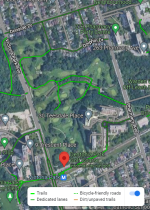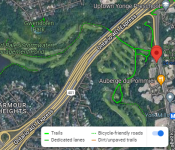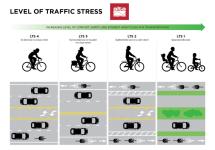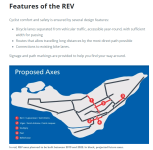Only to their own self interest.
What's this thread about again? Oh, yeah.

Only to their own self interest.

The courses in question already have public walking trails. I think the whining is about having to stay on the trails while walking through the courses. Both courses have hude parks that are larger than the courses adjacent, Earl Bales for Don Mills, Taylor Massey and Dentonia park abut Dentonia GC.Not officially. The debate on multi-use during the off season and potentially during the golf season most recently came up about 6 months ago.
Trails specifically have been mentioned from time to time. Except for sneaking in during the dead of winter there is no regular access for hikers and people on walks through the ravine system.


The number is 400,000 trips per week, not the number of riders. It's also the peak number, not the average. During peak good weather days Toronto has approx. 33,000 to work/school and back cyclists.Like hell there are almost 400,000 people riding to work daily. Probably an order of magnitude less than that on the best day and many days of the year, two orders of magnitude less. Probably three orders of magnitude less on a bad day. If you look at traffic counts, bicycles are at least a few orders of magnitude down from cars. I dont know where you got those numbers but they are pure fantasy. Sure, that many people may own bikes but a quick look in a condo bike locker shows that 95% of them are abandoned.
Like hell there are almost 400,000 people riding to work daily.
That seems much more plausible. There are ~400,000 vehicles on the 401 through Toronto on an average day. It doesn't take much critical thinking to realize there are not that many bikes commuting to work. How many cars do you see while driving? How many bikes? 400,000 bike commuters a day is beyond laughable. It shouldn't be, bike commuting would work well much of the year but very few people do it.The number is 400,000 trips per week, not the number of riders. It's also the peak number, not the average. During peak good weather days Toronto has approx. 33,000 to work/school and back cyclists.
Math is not that hard, follow me.I actually took the more "conservative" estimate I could find.
Ipsos says 54% of Torontonians cycle and 29% of those use their bike regularly for utilitarian purposes that estimate puts it up to nearly a million.
First of all you have all of the dodginess of polling and people providing answers based on thoughts not reality. Secondly, using a bike for utility does not necessarily mean you commute on it daily. Maybe they use a bike to go to the store once a month or once a year.Math is not that hard, follow me.
54% of 2 700 000 is 1 458 000.
29% of 1 458 000 is 422 820.
I’m here just for math. 422 820 < 1 000 000.First of all you have all of the dodginess of polling and people providing answers based on thoughts not reality. Secondly, using a bike for utility does not necessarily mean you commute on it daily. Maybe they use a bike to go to the store once a month or once a year.
Actual counted bicycles on major bicycle routes are pretty damned low compared to cars on the best day of the year.
I don't buy that.
You keep blaming infrastructure as the reason cyclists run reds, stops and x-walks, pass streetcars while loading, run without lights, speed...
Maybe you could take each of those infractions and explain what type of infrastructure will drive better behavior.


Yeah i'm sure you want to see all these people hop into cars. Or scooters? Or motorcycles?Easiest and cheapest way to change the infrastructure would be to ban bicycles, confiscate them when found, and auction them off somewhere else. That would be one heck of a cure.
That's a poll of 1500 people across the GTA, it is also an internet poll so the people interested in cycling are likely overrepresented.Math is not that hard, follow me.
54% of 2 700 000 is 1 458 000.
29% of 1 458 000 is 422 820.
Math is not that hard, follow me.
For example, Bikeshare Toronto claims they had 3.4million trips in 2021. If you do the math, 3.4M trips/6500 bikes in service means every Rideshare bike averages 14 trips per day, 365 days a year. Hmmm.
Actual counted bicycles on major bicycle routes are pretty damned low compared to cars on the best day of the year.
 ckan0.cf.opendata.inter.prod-toronto.ca
ckan0.cf.opendata.inter.prod-toronto.ca
the people riding for exercise would be most likely to blow a red because of the effort required to maintain..how did my courier buddy put it..'conservation of motion'?Fair observation!
We should take a step back and wonder why cyclists run reds, stops, xwalks, speed, etc, aka movement infractions.
Most of them are covered under one a umbrella-reason IMO
First
We have to understand that there are different types of cyclists with different tolerance levels to safety, lets use this graph below.
View attachment 57029
Most of the 'lycra-clad' dudes and messenger/couriers are LTS4
Most of the "commuters" and casual cyclists that run errands in the city are between LTS3 and LTS2 with a little bit of seasoned LTS4
Most families and kids are LTS1 with some LTS2 because they have no choice.
LTS1 usually are too worried about safety to break those laws and burn those reds so you won't have as many offenders. Maybe some clueless kids/pre-teens riding in small group might break some rules in there but they need protected bicycle infrastructure to get out and do their thing. They're also the most likely to take the sidewalk when protected infrastructure suddenly stops.
LTS2 might break a bit more rules but are generally still mostly law abiding citizens.
Now LTS3 and LTS4 usually are those that have more specific goals and/or are more in a hurry and are the most fearless of them all and while a bunch of them are going to respect the laws, a whole lot of them won't because their end goal to them > the impact they might have on their environment.
What do stop signs, red lights, xwalks, speed zones have in common? They require a change in speed and effort output. Whether it be fully stopping or reducing speed, the energy required for someone to get back up to speed/accelerate, especially from a stand still, is way greater than just maintaining your momentum. And we're talking 2 to 4 times the amount of energy, which i've personally observed with my power meter(in watts), but it's the same concept as higher gas mileage in city vs highway. Depending on how much you ride, this might make the difference between you being able to commute/work all week or not being able to do it if your body gets "taxed" beyond what it can sustain or if you ride in a group a few times a week, it might mean you can't keep up with them due to legs being too burnt. And that is without taking into consideration clipless pedals which are another risk factor every time you have to clip in and out of them. (EDIT: Also forgot to mention the redlights that dont detect cyclists at all at intersections)
All this to say, they want a way to get through in the most efficient manner.
Because most streets and roads downtown don't have flowing continuous infrastructure for bicycles, after stopping every 500m or block over a few dozen km, you start feeling the higher load of stop and go on the legs. The infrastructure in its current form penalizes the rider that stops at every stop sign and red light. It's literally more painful if you're at a level where you're faster (ie. 25km/h or faster) to keep doing the stop and go. That's partly why you'll see more rule breakers in the LTS4, and LTS3 groups, as they're usually the faster fitter ones with "more HP in the legs" and therefore expend more energy to reach those higher speeds and have more to "lose" when slowing down/stopping.
So just like people who drive through stop signs without fully stopping, and drive through reds, speed in residential areas and school zones, those cyclists are also trying to get to point B the fastest but also are trying to avoid being too beat up/exhausted. They don't see their actions having grave repercussions so they just keep doing it. It's generally the same rule breaking mentality you'll see in cars or motorcycles along with some preservation. I'm not saying it's right, i'm just saying that i'm 90% sure that's how most of them feel.
Well, it's like the difference between doing say 25 sprints acceleration followed by sustained effort, or a steady long effort.the people riding for exercise would be most likely to blow a red because of the effort required to maintain..how did my courier buddy put it..'conservation of motion'?
I'm not sure whether to laugh or cry.
We are doomed as a species.
we're not making it off this planet, imo.Well, it's like the difference between doing say 25 sprints acceleration followed by sustained effort, or a steady long effort.
One will jack up your body pretty quickly if you keep doing that daily. The other one is sustainable.
For a courier, if their legs are dead too soon, they can't work and will be short of a pay. And from what i can see they can easily do 80-100km + in a day. For someone who works on their legs like servers/bussers, etc... it can ruin your shift if legs are jacked up
The more i train in endurance sports the more i can see the parallels between the real world in terms of what works long term and what doesn't/gets you injured.
I do most of my bike workouts indoors to be honest, but you have to be okay with the "lobotomy" that comes with it lol
It's mind numbingly boring.
Excuses, excuses, excuses. I fall asleep when I drive at speed limit - that will be my excuse when an officer will stop me.Well, it's like the difference between doing say 25 sprints acceleration followed by sustained effort, or a steady long effort.
One will jack up your body pretty quickly if you keep doing that daily. The other one is sustainable.
For a courier, if their legs are dead too soon, they can't work and will be short of a pay. And from what i can see they can easily do 80-100km + in a day. For someone who works on their legs like servers/bussers, etc... it can ruin your shift if legs are jacked up
The more i train in endurance sports the more i can see the parallels between the real world in terms of what works long term and what doesn't/gets you injured.
I do most of my bike workouts indoors to be honest, but you have to be okay with the "lobotomy" that comes with it lol
It's mind numbingly boring.
Ok, good response. But isn't that argument the same for cars too? They require a lot more energy to accelerate and create a lot more pollution while doing so.Fair observation!
We should take a step back and wonder why cyclists run reds, stops, xwalks, speed, etc, aka movement infractions.
Most of them are covered under one a umbrella-reason IMO
First
We have to understand that there are different types of cyclists with different tolerance levels to safety, lets use this graph below.
View attachment 57029
Most of the 'lycra-clad' dudes and messenger/couriers are LTS4
Most of the "commuters" and casual cyclists that run errands in the city are between LTS3 and LTS2 with a little bit of seasoned LTS4
Most families and kids are LTS1 with some LTS2 because they have no choice.
LTS1 usually are too worried about safety to break those laws and burn those reds so you won't have as many offenders. Maybe some clueless kids/pre-teens riding in small group might break some rules in there but they need protected bicycle infrastructure to get out and do their thing. They're also the most likely to take the sidewalk when protected infrastructure suddenly stops.
LTS2 might break a bit more rules but are generally still mostly law abiding citizens.
Now LTS3 and LTS4 usually are those that have more specific goals and/or are more in a hurry and are the most fearless of them all and while a bunch of them are going to respect the laws, a whole lot of them won't because their end goal to them > the impact they might have on their environment.
What do stop signs, red lights, xwalks, speed zones have in common? They require a change in speed and effort output. Whether it be fully stopping or reducing speed, the energy required for someone to get back up to speed/accelerate, especially from a stand still, is way greater than just maintaining your momentum. And we're talking 2 to 4 times the amount of energy, which i've personally observed with my power meter(in watts), but it's the same concept as higher gas mileage in city vs highway. Depending on how much you ride, this might make the difference between you being able to commute/work all week or not being able to do it if your body gets "taxed" beyond what it can sustain or if you ride in a group a few times a week, it might mean you can't keep up with them due to legs being too burnt. And that is without taking into consideration clipless pedals which are another risk factor every time you have to clip in and out of them.
All this to say, they want a way to get through in the most efficient manner.
Because most streets and roads downtown don't have flowing continuous infrastructure for bicycles, after stopping every 500m or block over a few dozen km, you start feeling the higher load of stop and go on the legs. The infrastructure in its current form penalizes the rider that stops at every stop sign and red light. It's literally more painful if you're at a level where you're faster (ie. 25km/h or faster) to keep doing the stop and go. That's partly why you'll see more rule breakers in the LTS4, and LTS3 groups, as they're usually the faster fitter ones with "more HP in the legs" and therefore expend more energy to reach those higher speeds and have more to "lose" when slowing down/stopping.
So just like people who drive through stop signs without fully stopping, and drive through reds, speed in residential areas and school zones, those cyclists are also trying to get to point B the fastest but also are trying to avoid being too beat up/exhausted. They don't see their actions having grave repercussions so they just keep doing it. It's generally the same rule breaking mentality you'll see in cars or motorcycles along with some preservation. I'm not saying it's right, i'm just saying that i'm 90% sure that's how most of them feel.
How do you keep that from happening then?
You build more flowy infrastructure that doesn't require full stops every block, whether it be with more yield signs, idaho stop legislations, more roundabouts or you could have some dedicated through streets that are bicycle "priority" for most hours of the day. Exchange notes with other places that have done changes recently, like montreal, that get real winters compared to us to learn how to build a better cohesive network (the pic below isn't their full network, it's just the "Express" system they've built) Bloor/Danforth is a start but there needs to be a few options throughout the city that can include those LTS1 and LTS2 riders, as these are the people you truly want to add to your network, LTS4 will do what they want sadly.
View attachment 57044
TL;DR, infrastructure that creates constant stop and go on a bike is more physically taxing to the body at higher speeds/efforts which makes people more likely to choose the path of least resistance over longer trips. Just like other road users that don't need to expend energy for their "point A to point B" trips, some will cut corners and break laws by doing so. In order to curb that behaviour, infrastructure that allows for continuous cycling with less stops should be encouraged, along with infrastructure that creates a safer cycling environment in order to recruit more casual riders (LTS2 and LTS1) who will have a more law-abiding interactions with other road users.
As for the people riding without lights at night, they are just plain idiots... akin to people who don't know how their lighting system on their car works.
Yeah i'm sure you want to see all these people hop into cars. Or scooters? Or motorcycles?
Bringing the same "careless" mentality from those offenders into higher powered vehicles might no workout so well.
More accidents that cause more damage and more traffic because...well, more cars = more traffic.
Ok, good response. But isn't that argument the same for cars too? They require a lot more energy to accelerate and create a lot more pollution while doing so.
The energy used for stop/start is relevant to the energy used at higher speeds. Traveling 10KM at 40kmh requires more than twice as much energy as doing the same at 20kmh. If the argument is the environment -- they generate less than 1/2 the Co2 at 20kmh.
Completely fair.Excuses, excuses, excuses. I fall asleep when I drive at speed limit - that will be my excuse when an officer will stop me.
Ok, good response. But isn't that argument the same for cars too? They require a lot more energy to accelerate and create a lot more pollution while doing so.

